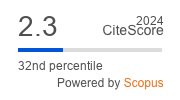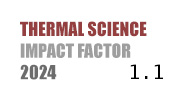ABSTRACT
The strata temperature has over 40˚C in the depth over 800 m of metal mine, it seriously affects the efficiency of excavation. In this paper, heat sources in deep space are systematically analyzed, and the heat calculation model are achieved and its release rules evaluated. According to field monitoring, the thermal influencing factors of shaft, horizontal gallery and excavation surface are investigated. Through numerical-analysis, the “assumption-correction” iterative trial algorithm is studied to calculate air-flow temperature, a set of prediction index is established, which can predict air-flow temperature and judge heat level face with temperature threshold. By comparing field monitoring results with the model prediction data, it, the method shows well reliability for evaluated thermal environment in deep resources mining.
KEYWORDS
PAPER SUBMITTED: 2024-07-20
PAPER REVISED: 2024-10-12
PAPER ACCEPTED: 2024-11-19
PUBLISHED ONLINE: 2025-05-03
THERMAL SCIENCE YEAR
2025, VOLUME
29, ISSUE
Issue 2, PAGES [1173 - 1178]
- Wagner, H., The Management of Heat Flow in Deep Mines (Part 2), Geomechanics and Tunnelling, 4 (2011), 2, pp. 157-163
- Dong L. J., et al., Safe and Intelligent Mining: Some Explorations and Challenges in the Era of Big Data, Journal of Central South University, 30 (2023), 6, pp. 1900-1914
- Zhao J. L., et al., Mapping Knowledge Domains for Mine Heat Hazard: a Bibliometric Analysis of Research Trends and Future Needs, Environmental Science and Pollution Research, 30 (2023), 7, pp.17076-17093
- Onder, M., et al., Psychrometric Analysis of a Fully Mechanized Underground Coal Mine and Establishment of Acceptable Climate Conditions, Journal of Mining Science, 57 (2021), 5, pp. 863-872
- Wang Y. J., et al., Numerical Study on Calculation Model of Air-flow Temperature and Humidity Prediction in Humid Airway, Energy Science & Engineering, 11 (2023), 6, pp. 1985-1997
- Bahonar, M., et al., A Semi-Unsteady-State Wellbore Steam/Water Flow Model for Prediction of Sandface Conditions in Steam Injection Wells, The Journal of Canadian Petroleum Technology, 49 (2010), 9, pp. 13-21
- Yu., A., et al., Procedure of Joint Calculation of Temperature and Ventilation Mode in Uninterrupted Mining in Permafrost Zone, Journal of Mining Science, 49 (2013), 1, pp. 126-131
- Xu, Y., et al, A Thermal Environment Prediction Method for a Mine Ventilation Roadway Based on a Numerical Method: A Case Study, Case Studies in Thermal Engineering, 42 (2023), ID102733
- Wu, B. S., et al., A Model for Downhole Fluid and Rock Temperature Prediction during Circulation, Geothermics, 50 (2014), Apr., pp. 202-212
- Bascompta, M., et al., Temperature Prediction Model in the Main Ventilation System of an Underground Mine, Applied Sciences, 10 (2020), ID7238
- Wala, A. M., et al., Mine Face Ventilation: A Comparison of CFD Results Against Benchmark Experiments for the CFD Code Validation, Mining Engineering, 59 (2007), 10, pp. 1-7
- Parra, M. T., et al., Numerical and Experimental Analysis of Different Ventilation Systems in Deep Mines, Building and Environment, 41 (2006), 2, pp. 87-93
- Hargreaves, D. M., et al., The Computational Modelling of the Ventilation Flows Within a Rapid Development Drivage, Tunnelling and Underground Space Technology, 22 (2007), 2, pp. 150-160
- Yurdakul, M., et al, Modelling Uniaxial Compressive Strength of Building Stones Using Non-destructive Test Results as Neural Networks Input Parameters, Construction and Building Materials, 47 (2013), Oct., pp. 1010-1019
- C.O. Karacan, Development and Application of Reservoir Models and Artificial Neural Networks for Pptimizing Ventilation Air Requirements in Development Mining of Coal Seams, International Journal of Coal Geology, 72 (2007), 3, pp. 221-239
- Wei, D. Y., et al., Thermal Environment Assessment of Deep Mine Based on Analytic Hierarchy Process and Fuzzy Comprehensive Evaluation, Case Studies in Thermal Engineering, 19 (2020), ID100618

